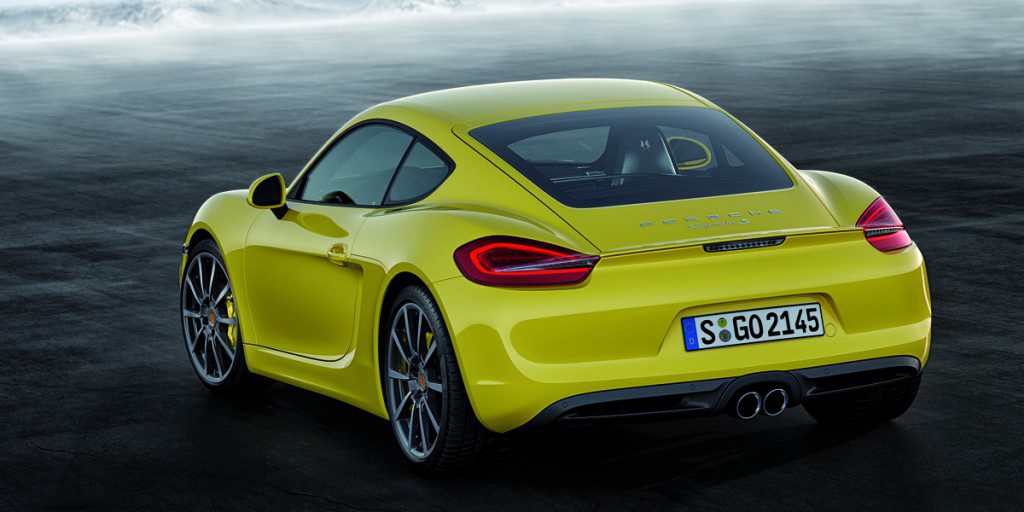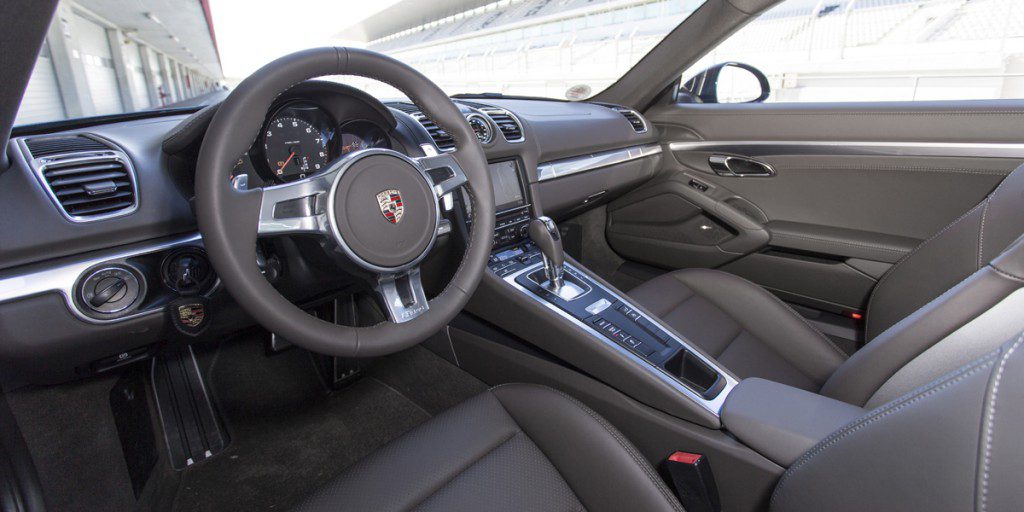| Premium sporty/performance car; Built in |
|
|
| Good condition price range: $39,300 – $65,300* |

2014 Porsche Cayman S

2014 Porsche Cayman S

2014 Porsche Cayman S
| Pros: |
|
| Cons: |
|
Some less-expensive sports cars challenge Cayman on a fun-per-dollar basis, and some like-priced competitors deliver more horsepower. Few however match the Cayman’s range of strengths: road manners and mechanical sophistication to satisfy the most discriminating driver, a good dose of everyday usability, and the cachet of the Porsche brand.
Overview
The Cayman was the hardtop-coupe version of Porsche’s two-seat, mid-engine Boxster convertible. The two cars shared a platform and used mid-mounted, horizontally opposed (“flat”) 6-cylinder engines. The Cayman and Boxster could be considered Porsche’s “entry-level” sports cars; both were priced far below the Porsche 911, though the Cayman’s base price was about $3,000 more than a Boxster.
The Cayman debuted for the 2006 model year and saw minor year-to-year updates through 2012. After skipping the 2013 model year, the Cayman was redesigned for 2014.
Because of its two trim levels and long list of optional features, Cayman spanned a rather broad price range. As such, it competed with a variety of premium sporty/performance cars in terms of price and performance. Cayman’s rivals included the Audi TT RS, BMW 1-Series, and Chevrolet Corvette
The 2014 Porsche Cayman was built in Germany.
The redesigned 2014 Cayman was based on the basic platform that debuted with the 2013 Porsche Boxster, so once again it more or less paralleled the features of its drop-top sibling. Though the Cayman’s wheelbase increased by 2.3 inches, overall length changed only fractionally. Porsche claimed a weight reduction of up to 60 pounds, depending on the model. Powertrains were revised, and new available features included adaptive cruise control and keyless entry and starting.
As with the previous-generation Cayman, the 2014 model was offered in Base and uplevel S models. The high-performance Cayman R model, which debuted as an early 2012 model, was discontinued.
Standard equipment on the base Cayman included 18-inch wheels, rain-sensing wipers with heated washers, faux suede/leatherette upholstery, Bluetooth wireless cell-phone link, and a fuel-saving auto stop/start feature. In addition to a larger, more powerful engine and 19-inch wheels, the Cayman S gained minor trim upgrades and HID auto-leveling headlamps.
Stand-alone options were numerous, and included a heated steering wheel, 14-way or 18-way power sport seats, front and rear obstacle detection, adaptive cruise control, Bose-brand audio system, and keyless entry and starting.
A Convenience Package included dual-zone automatic climate control and heated seats. A Premium Package added auto-dimming mirrors, but could only be ordered with one of the optional sport-seat upgrade packages. An Infotainment Package included a navigation system, satellite radio, and a Bose-brand or Burmester-brand sound system.
Performance-focused options included lightweight carbon-ceramic disc brakes, Power Steering Plus with speed-variable assist, and a Sport Chrono package. The last included a dashboard stopwatch/lap timer and a Sport Plus button that modified powertrain and suspension responses for normal and track-style driving. Also available was the Porsche Active Suspension Management (PASM) system, basically special “magnetic” shock absorbers that changed firmness through normal and sport modes, also selected with a Sport Plus button. PASM could be supplemented with optional Porsche Torque Vectoring (PTV) limited-slip differential, which apportioned power between the rear wheels as needed for improved cornering response and stability. Also available were 20-inch wheels and a dual-mode sport exhaust system.
The base Cayman’s “flat” 6-cylinder engine displaced 2.7 liters and had 275 horsepower. The S had a 325-horsepower 3.4-liter unit. Both engines now included an automatic idle-stop feature, similar to that on many gas/electric hybrids. Also new was a “coasting” function that, when activated, decoupled the transmission and cut the engine to idle speed, thus allowing the car to “sail” for longer distances. A final new fuel-saver was an energy recuperation system. This converted kinetic energy to electricity for running accessories and charging the battery, and thus reduced the amount of fuel-sapping drag from the engine-driven alternator.
On both Cayman and Cayman S, a 6-speed manual transmission was standard and Porsche’s “PDK” 7-speed dual-clutch automated manual was optional. The PDK gearbox could be set to shift like a conventional automatic or manually operated via the gear lever or steering-wheel paddles. A standard Sport button altered engine parameters to favor fuel economy or power delivery. On cars with the PDK transmission, the Sport Plus button could be used to deactivate the idle-stop and coasting features and to select a more-aggressive “racing track” shift program.
All Caymans were rear-wheel drive.
EPA fuel-economy estimates for the base 2014 Cayman were 21 mpg city/30 highway with the 6-speed manual transmission and 22/32 with the 7-speed automated manual. The 2014 Cayman S was rated at 20 city/28 highway with the manual and 21/30 with the automated manual.
All Caymans required premium-grade gasoline.
The 2014 Porsche Cayman included a standard complement of expected and federally mandated safety features, including antilock brakes (ABS), stability system, traction control, and seat-mounted side airbags that provided head and torso protection.
Yearly Updates
| 2014 Cayman |
